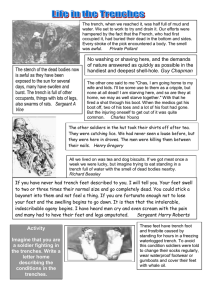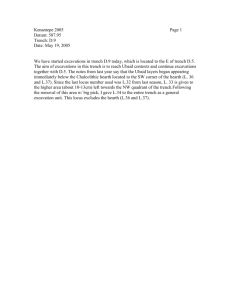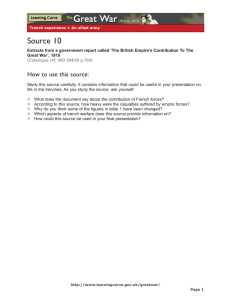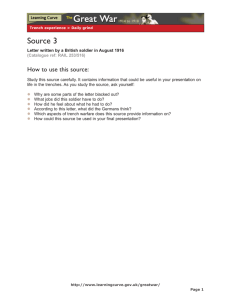SECTION 31 41 33 - TRENCH SAFETY PART 1 - GENERAL A.
advertisement
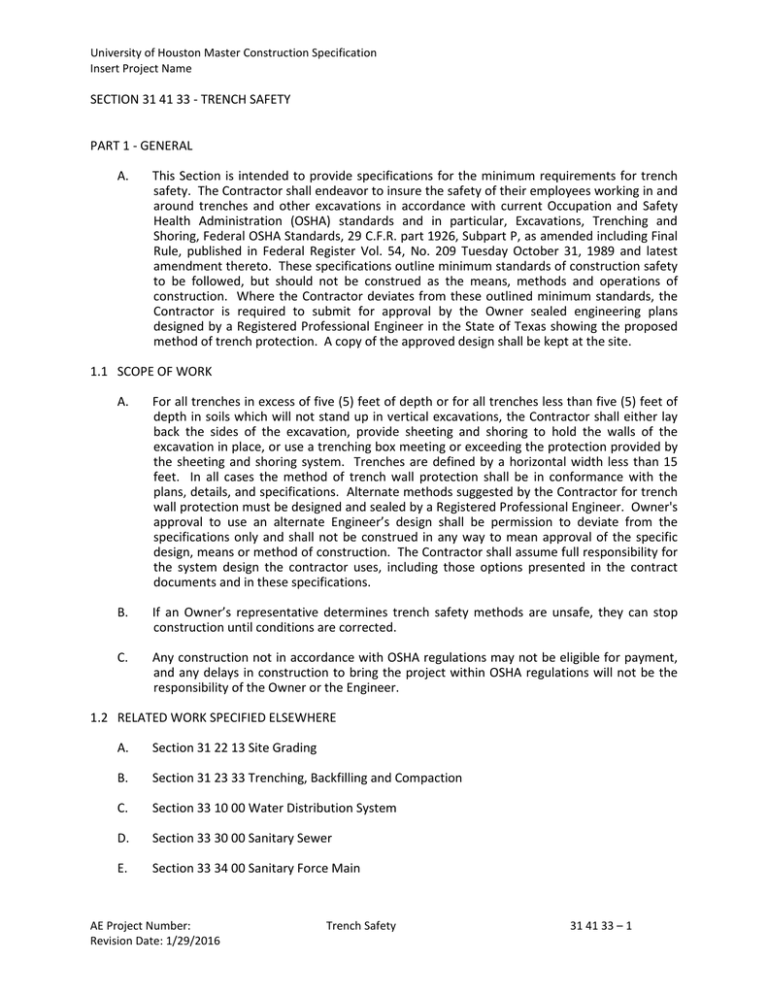
University of Houston Master Construction Specification Insert Project Name SECTION 31 41 33 - TRENCH SAFETY PART 1 - GENERAL A. This Section is intended to provide specifications for the minimum requirements for trench safety. The Contractor shall endeavor to insure the safety of their employees working in and around trenches and other excavations in accordance with current Occupation and Safety Health Administration (OSHA) standards and in particular, Excavations, Trenching and Shoring, Federal OSHA Standards, 29 C.F.R. part 1926, Subpart P, as amended including Final Rule, published in Federal Register Vol. 54, No. 209 Tuesday October 31, 1989 and latest amendment thereto. These specifications outline minimum standards of construction safety to be followed, but should not be construed as the means, methods and operations of construction. Where the Contractor deviates from these outlined minimum standards, the Contractor is required to submit for approval by the Owner sealed engineering plans designed by a Registered Professional Engineer in the State of Texas showing the proposed method of trench protection. A copy of the approved design shall be kept at the site. 1.1 SCOPE OF WORK A. For all trenches in excess of five (5) feet of depth or for all trenches less than five (5) feet of depth in soils which will not stand up in vertical excavations, the Contractor shall either lay back the sides of the excavation, provide sheeting and shoring to hold the walls of the excavation in place, or use a trenching box meeting or exceeding the protection provided by the sheeting and shoring system. Trenches are defined by a horizontal width less than 15 feet. In all cases the method of trench wall protection shall be in conformance with the plans, details, and specifications. Alternate methods suggested by the Contractor for trench wall protection must be designed and sealed by a Registered Professional Engineer. Owner's approval to use an alternate Engineer’s design shall be permission to deviate from the specifications only and shall not be construed in any way to mean approval of the specific design, means or method of construction. The Contractor shall assume full responsibility for the system design the contractor uses, including those options presented in the contract documents and in these specifications. B. If an Owner’s representative determines trench safety methods are unsafe, they can stop construction until conditions are corrected. C. Any construction not in accordance with OSHA regulations may not be eligible for payment, and any delays in construction to bring the project within OSHA regulations will not be the responsibility of the Owner or the Engineer. 1.2 RELATED WORK SPECIFIED ELSEWHERE A. Section 31 22 13 Site Grading B. Section 31 23 33 Trenching, Backfilling and Compaction C. Section 33 10 00 Water Distribution System D. Section 33 30 00 Sanitary Sewer E. Section 33 34 00 Sanitary Force Main AE Project Number: Revision Date: 1/29/2016 Trench Safety 31 41 33 – 1 University of Houston Master Construction Specification Insert Project Name F. Section 33 40 00 Drainage PART 2 - PRODUCTS A. Materials used for sheeting, sheet piling, cribbing, bracing, shoring, underpinning, and other structural retaining systems shall be in good serviceable condition, of good quality, of a suitable condition and grade to perform the intended use. Wood shall be sound, free from large or loose knots, and of the proper dimensions. The Contractor shall be responsible for maintaining the systems in a manner consistent with the intended design and in a manner that will prevent exposure of workers to hazards. PART 3 - EXECUTION 3.1 GENERAL SAFETY REQUIREMENTS A. The work area shall be kept free of hazards to the employees. All surface encumbrances which may create a hazard shall be removed, supported or otherwise isolated as necessary to safeguard employees. B. The Contractor shall take special precautions to locate existing utilities and to protect those systems as required. The Contractor shall call the Utility Coordinating Committee as required 24 hours prior to excavating around existing utilities. C. The Contractor shall provide safe access and egress to excavations. Ramps or stairways shall be structurally sound and capable of providing a safe means of escape from the excavation. Trenches in excess of four (4) feet in depth shall have a safe means of egress from the trench spaced such that no more than 25 feet of lateral travel would be required to reach the egress system. D. The employees shall be protected from work place hazards such as vehicular traffic, falling loads, and hazardous atmosphere. Excavations shall be marked so that employees and equipment are clearly warned of the location of the excavations. Trenches shall be kept free of water accumulations that would present a hazard to employees. Adjacent structures shall be stabilized as necessary so as not to present a possible hazard to the employees. Equipment shall be kept sufficiently clear of excavations so as not to create a potential overburden stress to trench walls causing cave-ins. Safe access shall be provided with handrails where access over trenches is required. E. Emergency rescue equipment as required by OSHA shall be readily available at the site and shall be maintained to good working condition. F. Daily inspections of excavations, the adjacent areas, and the protective systems shall be made by a person or persons competent to make such inspections to keep the Contractor notified of unsafe conditions so that necessary precautionary actions can be taken. 3.2 TRENCH WALL LAYBACK A. General In areas where no pavement or other structural elements are to be constructed, the sides of the trenches over five (5) feet deep may be sloped to provide protection from cave ins. If written approval is given by the Owner, trenches beneath pavement or other structures may AE Project Number: Revision Date: 1/29/2016 Trench Safety 31 41 33 – 2 University of Houston Master Construction Specification Insert Project Name also be laid back. Backfill for laid back trenches shall be as provided for a vertical wall trench for the full width of the excavation. B. Layback Slope Requirements 1. The Contractor shall be responsible for providing the proper lay back slopes for all soil conditions encountered. Where soils data is provided for the Contractor's use, that information is intended as a sampling of the types of soils materials that may be encountered; however, the Contractor shall be diligent in observing the actual soil conditions as the work proceeds and shall be responsible for providing a safety system adequate to meet the minimum standards for the actual types of soils encountered. Special precautions shall be taken to monitor conditions when working in fill areas, areas subject to surcharge and areas exposed to vibrations from nearby equipment and machinery. 2. At the Contractor’s option where a layback trench system is approved for use, the Contractor may layback the sides of the trench at a slope of one and one-half (1-1/2) feet horizontal to one (1) foot vertical without testing for the soil’s stability. When this method is used, it does not preclude the removal of unsuitable materials encountered and replacement with suitable materials. This method shall not be used in unsuitable soils such as wet sands, silts, peat or in other areas which require special procedures, equipment and materials. 3. The Contractor may engage a competent person in the means of soil classification to determine the soil classification as a means of reducing the trench wall slopes. Layback slopes may be sloped up to the maximum allowable slopes as follows for the given types of soil. MAXIMUM ALLOWABLE SLOPES For Excavations Less than 20 Feet Deep [c] Slope H:V Soil Materials Stable Rock Type A-[b] Type B Type C Notes: 4. Vertical 3/4:1 1:1 1 1/2:1 (90°) (53°) (45°) (34°) a) Numbers shown in parentheses next to maximum allowable slopes are angles expressed in degrees from the horizontal. Angles have been rounded off. b) A short-term maximum allowable slope of 1/2H:1V (63°) is allowed in excavations in Type A soil that are 12 feet (3.67 m) or less in depth. Short-term maximum allowable slopes for excavations greater than 12 feet (3.67 m) in depth shall be 3/4H:1V (53°). c) Sloping or benching for excavations greater than 20 feet deep shall be designed by a registered professional engineer. The types of soil given in paragraph 3.2.B are defined as follows: AE Project Number: Revision Date: 1/29/2016 Trench Safety 31 41 33 – 3 University of Houston Master Construction Specification Insert Project Name a) Stable Rock - Natural solid mineral matter that can be excavated with vertical sides and remain in tract while exposed. b) Type A - Cohesive soils with an unconfined compressive strength of 1.5 tons per square foot or greater. Examples of cohesive soils are: clay, silty clay, sandy clay, clay loam and in some cases, silty clay loam and sandy clay loam cemented soils such as caliche and hard pan are also considered Type A. However, no soil is Type A if: i. c) d) AE Project Number: Revision Date: 1/29/2016 The soil is fissured. ii. The soil is subject to vibration from heavy traffic, piling driving, or similar effects. iii. The soil has been previously disturbed. iv. The soil is part of a sloped, layered system where the layers dip into the excavation on a slope of four horizontal to one vertical or greater. v. The soil is subject to other factors that would require it to be classified as a less stable material. Type B - Soil that meets one of the following: i. Cohesive soil with an unconfined compressive strength greater than 0.5 tons per square foot, but less than 1.5 tons per square foot. ii. Granular cohesionless soils including: angular gravel, silt, silt loam, sandy loam and in some cases, silty clay loam and sandy clay loam. iii. Previously disturbed soils except those which would otherwise be classified as Type C soil. iv. Soil that meets the unconfined compressive strength or cementation requirements for Type A, but is fissured or subject to vibration. v. Dry rock that is not stable. vi. Material that is part of a sloped, layered system where the layers dip into the excavation on a slope less steep than four horizontal to one vertical, but only if the soil would otherwise be classified as Type B. Type C - Soil that meets one of the following: i. Cohesive soil with an unconfined compressive strength of 0.5 tons per square foot or less. ii. Granular soils including: gravel, sand and loamy sand. iii. Saturated or submerged soil. Trench Safety 31 41 33 – 4 University of Houston Master Construction Specification Insert Project Name iv. Submerged rock that is not stable. v. Soil in a sloped, layered system where the layers dip into the excavation on a slope of four horizontal to one vertical or greater. 5. Unconfined compressible strength shall mean the load per unit area at which a soil will fail in compression. It can be determined by laboratory testing, estimated in the field using a pocket penetrometer, or other previously approved methods. 6. Wet soil shall mean soil that contains significantly more moisture than moist soil, but in such a range of values that cohesive material will slump or begin to flow when vibrated. Granular material that would exhibit cohesive properties when moist will lose those cohesive properties when wet. 7. Layered systems shall be classified in accordance with its weakest layer; however, each layer may be classified individually where a more stable layer lies under a less stable layer. 8. Previously classified material whose properties, factors, or conditions affecting its classification change in any way shall be reclassified as necessary and changes to the trench safety plan shall be accomplished before continuing any work in or near the trench where there may be potential danger to workers due to trench failure. 9. The slope of a laid back trench wall shall be less steep than the maximum allowable slope when there are signs of distress. The maximum allowable slope for a material in distress shall be 1/2 horizontal to one vertical or less steep than the maximum allowable slope for the material in a non-distressed condition. Distress shall mean a condition in which a cave-in is imminent or likely to occur. 10. When surcharge loads from adjacent structures, stored material or equipment, operating equipment, or traffic are present, a competent person shall determine the degree to which the actual slope must be reduced below the maximum allowable slope, and shall assure that such a reduction is achieved. 11. An adequate means of exit such as a ladder or steps shall be provided and located so as to require no more than 25 feet of lateral travel to exit the trench. 3.3 TIMBER SHORING A. General Timber shoring may be used as a means of trench protection from cave-ins in trenches that do not exceed 20 feet in depth. The timber shoring system may be used in lieu of sloping and benching systems, or in conjunction with those systems. Good judgment shall be used by the Contractor in selecting the proper system when alternative designs are given. B. Soil Classification The timber shoring system designs are subject to soil classifications outlined in 3.2.B.4 of this section. Classification shall be conducted by a competent person using the proper means and methods of classification as described in this section. C. Basis and Limitations AE Project Number: Revision Date: 1/29/2016 Trench Safety 31 41 33 – 5 University of Houston Master Construction Specification Insert Project Name 1. 2. Dimension of Timber Members a) The sizes of the timber members shown in the details are taken from the National Bureau of Standards (NBS) report, "Recommended Technical Provisions for Construction Practice in Shoring and Sloping of Trenches and Excavations." In addition where NBS did not recommend specific sizes for members, member sizes are based upon an analysis of the sizes required for use by existing codes and an empirical practice. b) The required dimensions of the members listed in the tables refer to actual dimensions and not nominal dimensions of the timber. Limitation of Application a) It is not intended that the timber shoring specification apply to every situation that may be experienced in the field. This data was developed to apply to situations that are anticipated to be present at the site. Where the system provided does not meet the requirement of the actual conditions in the field, the Contractor shall either notify the Owner of the situation and present an engineered solution designed and sealed by the Registered Professional Engineer, or shall notify the Owner of the unanticipated conditions and await instructions. b) When any of the following conditions are present, the members specified and shown in the details are not considered adequate. i. When loads imposed by structures or by stored material adjacent to the trench weigh in excess of the load imposed by a two foot soil surcharge. Adjacent shall mean the area within a horizontal distance from the edge of the trench equal to the depth of the trench. ii. When vertical loads imposed on crossbraces exceed a 240 pound gravity load distributed on a one foot section of the center of the crossbrace. iii. When surcharge loads are present from equipment weighing in excess of 20,000 pounds. iv. When only the lower portion of a trench is shored and the remaining portion of the trench is sloped or benched unless: (1) The sloped portion is sloped at an angle less steep than 3H:1V; (2) The members are selected from the tables based upon the total trench depth from the top of the overall trench and not the toe of the slope. 3. Cross braces or trench jacks shall be placed in true horizontal position, be spaced vertically, and be secured to prevent sliding, falling or kickouts. 4. Backfilling and removal of trench supports shall progress together from the bottom of the trench. Jacks or braces shall be released slowly and, in unstable soil, ropes shall be AE Project Number: Revision Date: 1/29/2016 Trench Safety 31 41 33 – 6 University of Houston Master Construction Specification Insert Project Name used to pull out the jacks or braces from above after employees have cleared the trench. 5. An adequate means of exit shall be provided such as a ladder or steps and shall be located so as to require no more than 25 feet of lateral travel to exit the trench. 6. Where necessary due to wet soils or other similar conditions, the shoring system shall use tight sheeting such that material is contained behind the sheeting. 3.4 ALTERNATIVE SHORING SYSTEMS A. General Alternative shoring systems may be used when approved by the Owner. Steel, aluminum or other approved materials may be used in lieu of wood for shoring where the system is designed, constructed and maintained in a manner that will give equal to or greater protection than the wood system. B. Sheet Piling Sheet piling may be used when approved by the Owner to shore the sides of the trench. Sheet piles shall be removed at the completion of the work unless otherwise directed by the Owner. When piling is to remain, the piling shall be cut off at least three feet from the top of the excavation or at least three feet from the top of the proposed finished grades, whichever is lower. The sheet piling system shall be designed by a Registered Professional Engineer and shall provide equal or greater protection than the specified wood shoring system. Materials for the piling shall be approved by the Owner. C. Trench Boxes Trench boxes that provide equal or greater protection as the specified wood shoring system may be used. The Contractor shall be responsible for insuring the adequacy, maintenance, and design of the trench box used. The Contractor shall also be responsible for the proper use and operation of the trench box. D. Shield Systems 1. 2. General a) Shield systems shall not be subjected to loads exceeding those which the system was designed to withstand. b) Shields shall be installed in a manner to restrict lateral or other hazardous movement of the shield in the event of the application of sudden lateral loads. c) Workers shall be protected from the hazard of cave-ins when entering or exiting the areas protected by shields. d) Workers shall not be allowed in trenches or shields when shields are being installed, removed, or relocated. Excavations of earth material to a level not greater than two feet below the bottom of a shield shall be permitted, but only if the shield is designed to resist the forces AE Project Number: Revision Date: 1/29/2016 Trench Safety 31 41 33 – 7 University of Houston Master Construction Specification Insert Project Name calculated for the full depth of the trench and there are no indications while the trench is open of a possible cave-in below the bottom of the shield. 3. Use of shields shall be subject to approval by the Owner. END OF SECTION AE Project Number: Revision Date: 1/29/2016 Trench Safety 31 41 33 – 8

